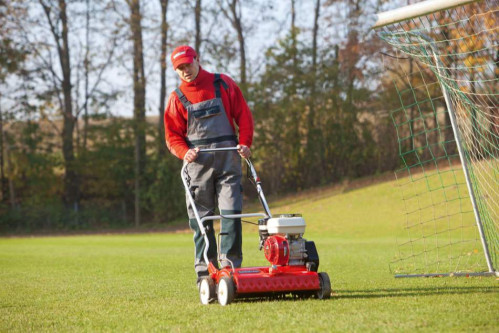Aerator and scarifier - what are the differences and in which construction projects can they be used?
Scarifiers and aerators are some of the basic equipment used for site preparation or landscaping work.

Scarifiers and aerators are some of the basic equipment used for site preparation or landscaping work. While they may seem similar in function, each serves a different purpose in the construction process. In this article, we will look at the differences between scarifiers and aerators, their key features, advantages and uses.
A scarifier is used to cut turf vertically, or scarify. Its purpose is to remove felt (a compacted layer of dead plants, moss and organic debris), which impedes the penetration of water, air and nutrients into the soil.
Key features and advantages of scarifiers:
- Versatility: scarifiers are available in a variety of sizes and can be equipped with different types of blades to suit different surface materials and project requirements.
- Surface preparation: scarifiers effectively level uneven surfaces, remove imperfections and create a rough texture to improve the adhesion of new coatings or materials.
- Efficiency: thanks to their high cutting power, scarifiers can cover a significant area in a relatively short period of time, making them very efficient for larger construction projects.
- Dust control: Many scarifiers are equipped with dust collection systems that minimize airborne dust particles, providing a safer and cleaner working environment.
Unlike scarifiers, an aerator is used to aerate the soil. Its main purpose is to improve soil structure by creating openings that allow better penetration of air, water and nutrients to grass roots. Aerators are commonly used for landscape preparation, golf courses, sports fields, as well as in horticulture.
Key features and advantages of aerators:
- Soil aeration: the primary function of aerators is to reduce soil compaction by creating air channels, promoting root growth and improving overall soil health.
- Water drainage: by creating channels, aerators improve water drainage, preventing surface water accumulation and reducing the risk of soil erosion.
- Nutrient absorption: increased oxygen flow resulting from aeration facilitates nutrient absorption by plant roots, leading to healthier vegetation.
- Time and labor savings: effectively solving soil compaction problems, aerators minimize the need for labor-intensive manual tasks such as plowing or manually loosening soil.
Scarifiers and aerators are tools, used once a year - therefore, the most cost-effective solution in terms of money is to rent them. If you are interested in renting such equipment, contact a Ramirent specialist!